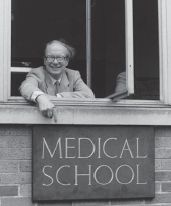
Physiology News Magazine
Obituary: Declan John Anderson
1920 – 2016
Membership
Obituary: Declan John Anderson
1920 – 2016
Membership
Bruce Matthews
https://doi.org/10.36866/pn.103.45

Declan Anderson was a dentist and physiologist; but foremost, a scientist. He died at the age of 95 on Easter Day, 27 March 2016. He was educated at Christ’s Hospital School and Guy’s Hospital. After graduating in dentistry in 1942, he went on to obtain a B.Sc. in Physiology in 1946, and a Ph.D. in 1955. During these latter studies, he held clinical posts and a lectureship in Physiology at Guy’s.
He published widely and his first paper, on the temperature changes in teeth produced by drilling, was on research done as an undergraduate. He was the first person to record masticatory forces in humans during natural chewing. He did this with a miniature transducer that he skilfully engineered and incorporated into a gold inlay in a molar. This was featured in a live broadcast from his laboratory in one of the early programmes in the BBC’s Tomorrow’s World series. But he is best known for his work on the sensory mechanisms responsible for pain from human dentine, a field to which he and his students have contributed extensively. His early work on this topic, together with that of Martin Brännström in Stockholm, provided evidence that the sensitivity of dentine was not due to stimulation of bare nerve endings when dentine was exposed, but to the displacement of the contents of the dentinal tubules to which the stimuli had been applied. It was postulated that this displacement then activated sensory receptors sensitive to movement or pressure changes deeper in the dentine or in the underlying dental pulp. The extent to which dentine was innervated was hotly disputed at the time: the histological evidence was inconclusive because of problems with fixing, sectioning and staining the calcified, non-vascular tissue, even after decalcification.
Declan showed that the topical application of local anaesthetic solutions to dentine did not desensitise it, and the application of isotonic solutions of KCl and other substances that cause pain when applied to exposed nerve endings in skin, do not cause pain when applied to exposed dentine. He also showed that the solutions that do cause pain from exposed dentine, such as sugar solutions, act by the osmotic effects they produce.
He found that the outer half of the dentine in the crown of a tooth, although sensitive to stimulation, is devoid of any vital cellular material, and that nerve terminals penetrate no further than 150 µm from the dental pulp into the dentinal tubules, which are 2 to 3 mm long. And not all tubules contain such nerve terminals.
Other experiments in his laboratory showed that many nerves in teeth are capable of responding to any form of stimulus that causes movement of the contents of the dentinal tubules, which was further evidence to support a hydrodynamic mechanism.
He also made important contributions to dental education. He believed strongly that staff involved in teaching or research in dental sciences should not be based in small, isolated departments in dental schools; but in larger departments in medical schools or the science faculties of universities. This emphasis on the integration of dental and medical sciences was reflected in his ‘Textbook of Physiology for Dental Students’, published in 1952.
He found support for this view in the 1960s from Arthur Darling, who was dean of the Faculty of Medicine in Bristol at the time, and also a dentist. As a result, Bristol created lectureship posts for dentists in the departments of Anatomy, Biochemistry, Physiology and Pharmacology in the Medical School, and a chair in Oral Biology for someone to oversee these posts and integrate basic science and clinical teaching in the Dental School. Declan was appointed to that chair in 1966, and remained in the post until he retired in 1985.
The group that he formed in Bristol was very successful, and representatives from dental schools around the world came to see how the system worked. Dental students were encouraged to intercalate a B.Sc. in a basic science during their course and continue to a Ph.D.; and many did so. As a result, a large number of senior posts in dental research in this country and abroad have been filled by Declan’s students. At the last count, 12 of his Ph.D. students are professors and amongst these are past or present heads of department and deans, and the editor of an international research journal.
Declan was great fun; he had a wonderful sense of humour and sharp wit. He always included amusing anecdotes relevant to the subject under discussion in his lectures, and they were very popular with students. He was very fond of practical jokes, which he often devised with his friend James Mansie, an oral surgeon at Guy’s.
Declan was an accomplished silversmith, and was commissioned to make many pieces as gifts or presentations for individuals and organisations; all with his DJA hallmark, of which he was very proud. He wrote a book on silversmithing.
His wife, Joy, predeceased him, as did two of their seven children.
